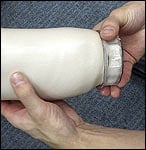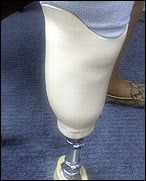An innovative idea that saves time and money, plus makes life easier for both patient and prosthetist, is always welcome. The SocketCone™, a quickly cast and fabricated socket, has a multitude of potential uses according to Chesapeake Medical Products Inc., Baltimore, Maryland, the developer and manufacturer.
The original concept for the SocketCone
was mentioned and discussed at the 2001 World Congress of the International Society for Prosthetics and Orthotics (ISPO) in Glasgow, Scotland, initially by Carson Harte, executive director of the Cambodia Trust, and secondly, by Wieland Kaphingst, OMM, CPO (EC), CP, notes Chesapeake Medical CEO Eric Johnson. Lee Shirer, inventor of the DupliCone™ low-temperature thermoplastic socket duplicating system, assisted with the development of the SocketCone™, Johnson adds.
According to Johnson, the SocketCone can be made in one hour, requiring only one patient visit, never requires plaster, and can be molded easily, either directly on the patient or on a cast.
Chesapeake Medical Products notes the following applications for the SocketCone:
- Temporary prosthesis.
- Dynamic test socket.
- Rigid dressing.
- IPOP.
- Shower/swim leg.
- Spare prosthesis.
The SocketCone also could be used as a cost-effective socket in developing nations, the company adds, and is “infinitely adjustable.” A heat gun can be used for spot adjustments, plus the socket can be completely reheated and re-molded, except for the hardware at the distal end, thus enabling adjustment for residual limb volume loss.
Amy Holm of Valrico, Florida, told The O&P EDGE how pleased she is with the socket. Holm, a right transtibial amputee since the age of two, says, “I never was this comfortable before. I can’t believe how comfortable this is!” Holm, who has undergone several surgeries, says that her residual limb is basically “nothing but bone and flesh. You could circle the tip of my residual limb with your thumb and forefinger”-thus not an easy limb to make comfortable. Holm also was impressed with how little time was needed for fabrication and fit. “It saved me so much time! It was molded to my leg and heated to shape it-it felt warm, not hot-and I was done!”
SocketCones are made from a low-temperature (160 degrees F) thermoplastic reinforced with Kevlar, a high-strength, lightweight fiber used to make such products as airplane wings, spacecraft parts, and bullet-resistant vests.
A SocketCone socket costs slightly more in materials to make than a typical check socket, but the savings in time for both patient and prosthetist, plus the fact the socket has various other potential uses, outweigh the cost, said Shirer. Socket cones are available in three sizes: medium, large, and x-large. A chart is available to select the best size for the patient. Chesapeake offers two distal end adapter kits to adapt to standard four-hole plates and the “hockey puck”-style shuttle locks. SocketCones may also be molded directly over a wide variety of existing lock systems. Chesapeake’s Shrinkee” sleeves should be used as a separator, since they are specially designed for use with the SocketCone. “They are both easy to use and perform far better than plastic wrap, stretch wrap, or PE bags,” says the company.
For more information, call Eric Johnson at Chesapeake Medical Products Inc., 410.574.4171 or 888.560.2674; or e-mail: [email protected]
SocketCone FAQs |
|
Will a SocketCone stick? SocketCones are treated with a nonstick coating inside and out, which helps the cone from sticking to itself. A separator-petroleum jelly or liquid soap for dishes-is strongly recommended when shaping. How will I know when the plastic is ready to mold? When heating the SocketCone for the first time, give this step your full attention. It takes three to five minutes depending on your heat source. A timer will help establish consistent results. Do not overheat! If it feels too hot to handle with bare hands or is so “floppy” you cannot work with it easily, you have heated it too long. Allow the SocketCone to cool off to the proper working temperature of 160 degrees F. It should be pliable and easy to mold. Overheating is basically the only way to cause molding difficulties of the SocketCone; otherwise they are nearly foolproof. Do not try to heat them in a 350-degree oven. How can the SocketCone be modified? A heat gun is the easiest and most conservative method. You can grind the material and buff with standard tools if you wish. Cool with a wet sponge or water mist after applying heat and modifying. A torch is not recommended nor needed. How do I finish the trimlines? The best method is to grind with a small-toothed metal bit and buff. To smooth even more, heat trimlines and smooth with wet fingers. |
Steps to Fabricating and Fitting a SocketCone Prosthesis |
||||||||
|
The SocketCone is used primarily to create a temporary prosthesis and is currently available in three transtibial-sized cones. It also makes an excellent IPOP, according to the company. |
||||||||

|
|
|
||||||
|
|
|
||||||
|
A free DVD which demonstrates the process in detail is available from Chesapeake Medical Products Inc. and will help the prosthetist or technician to obtain optimal results with the SocketCone. The company also offers several inexpensive low-temperature heating devices. |
||||||||









